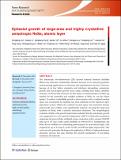| dc.contributor.author | Cui, Fangfang | |
| dc.contributor.author | Li, Xiaobo | |
| dc.contributor.author | Feng, Qingliang | |
| dc.contributor.author | Yin, Jianbo | |
| dc.contributor.author | Zhou, Lin | |
| dc.contributor.author | Liu, Dongyan | |
| dc.contributor.author | Liu, Kaiqiang | |
| dc.contributor.author | He, Xuexia | |
| dc.contributor.author | Liang, Xing | |
| dc.contributor.author | Liu, Shengzhong | |
| dc.contributor.author | Lei, Zhibin | |
| dc.contributor.author | Liu, Zonghuai | |
| dc.contributor.author | Peng, Hailin | |
| dc.contributor.author | Zhang, Jin | |
| dc.contributor.author | Kong, Jing | |
| dc.contributor.author | Xu, Hua | |
| dc.date.accessioned | 2019-06-27T18:50:45Z | |
| dc.date.available | 2019-06-27T18:50:45Z | |
| dc.date.issued | 2017-04-20 | |
| dc.date.submitted | 2016-12 | |
| dc.identifier.issn | 1998-0124 | |
| dc.identifier.issn | 1998-0000 | |
| dc.identifier.uri | https://hdl.handle.net/1721.1/121436 | |
| dc.description.abstract | The anisotropic two-dimensional (2D) layered material rhenium disulfide (ReSe2) has attracted considerable attention because of its unusual properties and promising applications in electronic and optoelectronic devices. However, because of its low lattice symmetry and interlayer decoupling, anisotropic growth and out-of-plane growth occur easily, yielding thick flakes, dendritic structure, or flower-like structure. In this study, we demonstrated a bottom-up method for the controlled and scalable synthesis of ReSe2 by van der Waals epitaxy. To achieve controllable growth, a micro-reactor with a confined reaction space was constructed by stacking two mica substrates in the chemical vapor deposition system. Within the confined reaction space, the nucleation density and growth rate of ReSe2 were significantly reduced, favoring the large-area synthesis of ReSe2 with a uniform monolayer thickness. The morphological evolution of ReSe2 with growth temperature indicated that the anisotropic growth was suppressed at a low growth temperature (<600 °C). Field-effect transistors employing the grown ReSe2 exhibited p-type conduction with a current ON/OFF ratio up to 105 and a hole carrier mobility of 0.98 cm2/(V·s). Furthermore, the ReSe2 device exhibited an outstanding photoresponse to near-infrared light, with responsivity up to 8.4 and 5.1 A/W for 850- and 940-nm light, respectively. This work not only promotes the large-scale application of ReSe2 in high-performance electronic devices but also clarifies the growth mechanism of low-lattice symmetry 2D materials. Keywords: rhenium diselenide (ReSe₂); epitaxial growth; high crystal quality; anisotropy; optoelectronics | en_US |
| dc.description.sponsorship | National Science Foundation (U.S.) (Grant DMR-1231319) | en_US |
| dc.language.iso | en | |
| dc.publisher | Springer Nature | en_US |
| dc.relation.isversionof | http://dx.doi.org/10.1007/s12274-017-1477-7 | en_US |
| dc.rights | Creative Commons Attribution-Noncommercial-Share Alike | en_US |
| dc.rights.uri | http://creativecommons.org/licenses/by-nc-sa/4.0/ | en_US |
| dc.source | other univ website | en_US |
| dc.title | Epitaxial growth of large-area and highly crystalline anisotropic ReSe2 atomic layer | en_US |
| dc.type | Article | en_US |
| dc.identifier.citation | Cui, Fangfang et al. "Epitaxial growth of large-area and highly crystalline anisotropic ReSe₂ atomic layer." Nano Research 10, 8 (August 2017): 2732-2742 © 2017 Tsinghua University Press and Springer-Verlag Berlin Heidelberg | en_US |
| dc.contributor.department | Massachusetts Institute of Technology. Department of Electrical Engineering and Computer Science | en_US |
| dc.contributor.department | Massachusetts Institute of Technology. Research Laboratory of Electronics | en_US |
| dc.eprint.version | Author's final manuscript | en_US |
| dc.type.uri | http://purl.org/eprint/type/JournalArticle | en_US |
| eprint.status | http://purl.org/eprint/status/PeerReviewed | en_US |
| dc.date.updated | 2019-06-26T17:46:04Z | |
| dspace.date.submission | 2019-06-26T17:46:05Z | |
| mit.journal.volume | 10 | en_US |
| mit.journal.issue | 8 | en_US |
